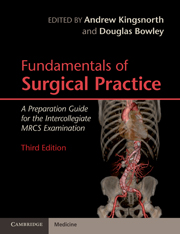Book contents
- Frontmatter
- Contents
- List of contributors
- Preface
- Section 1 Basic Sciences Relevant to Surgical Practice
- Section 2 Basic Surgical Skills
- Section 3 The Assessment and Management of the Surgical Patient
- Section 4 Perioperative Care of the Surgical Patient
- 11 Fundamentals of intestinal failure and nutrition
- 12 Enhanced recovery after surgery
- 13 Fundamentals of intensive care
- 14 Caring for surgical patients: complications and communication
- 15 Management of sepsis
- Section 5 Common Surgical Conditions
- Index
- References
13 - Fundamentals of intensive care
Published online by Cambridge University Press: 03 May 2011
- Frontmatter
- Contents
- List of contributors
- Preface
- Section 1 Basic Sciences Relevant to Surgical Practice
- Section 2 Basic Surgical Skills
- Section 3 The Assessment and Management of the Surgical Patient
- Section 4 Perioperative Care of the Surgical Patient
- 11 Fundamentals of intestinal failure and nutrition
- 12 Enhanced recovery after surgery
- 13 Fundamentals of intensive care
- 14 Caring for surgical patients: complications and communication
- 15 Management of sepsis
- Section 5 Common Surgical Conditions
- Index
- References
Summary
Introduction
Intensive care generally refers to the care of patients who are critically ill or injured, thereby requiring constant monitoring, frequent assessment and thoughtful intervention to facilitate a successful recovery. A thorough understanding of human physiology and how to support or correct alterations from the norm is essential in the treatment of such patients. Critical illness often affects the entire body and a multi-system approach must be considered. This chapter will address fundamentals of physiology, pathology and treatment of patients you will encounter in an intensive care setting.
Cardiovascular system
Simply, the cardiovascular system is composed of the heart and an extensive network of blood vessels. Its function is to deliver oxygen (perfusion) and nutrients to the entire body and take away the by-products of the body's utilization. While seemingly elementary, returning to this basic concept helps make the complexities of this intricate process understandable.
Physiology
The heart
The heart has four chambers, four valves, and is composed of specialized conduction tissue; its purpose is to pump blood throughout the body. The heart itself is perfused by right and left coronary arteries arising directly from the aorta. The left coronary artery leaves the aorta and is referred to as the ‘left main stem’ before it bifurcates into the circumflex artery and the left anterior descending (LAD) artery.
- Type
- Chapter
- Information
- Fundamentals of Surgical PracticeA Preparation Guide for the Intercollegiate MRCS Examination, pp. 190 - 229Publisher: Cambridge University PressPrint publication year: 2011

